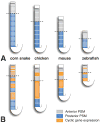Heterochrony and developmental timing mechanisms: changing ontogenies in evolution
- PMID: 24994599
- PMCID: PMC4201350
- DOI: 10.1016/j.semcdb.2014.06.015
Heterochrony and developmental timing mechanisms: changing ontogenies in evolution
Abstract
Heterochrony, or a change in developmental timing, is an important mechanism of evolutionary change. Historically the concept of heterochrony has focused alternatively on changes in size and shape or changes in developmental sequence, but most have focused on the pattern of change. Few studies have examined changes in the mechanisms that embryos use to actually measure time during development. Recently, evolutionary studies focused on changes in distinct timekeeping mechanisms have appeared, and this review examines two such case studies: the evolution of increased segment number in snakes and the extreme rostral to caudal gradient of developmental maturation in marsupials. In both examples, heterochronic modifications of the somite clock have been important drivers of evolutionary change.
Keywords: Developmental timing; Heterochrony; Limb; Marsupial; Somitogenesis; Timekeeping mechanisms.
Copyright © 2014 Elsevier Ltd. All rights reserved.
Figures




References
-
- Smith KK. Heterochrony revisited: the evolution of developmental sequences. Biological Journal of the Linnean Society. 2001;73:169–86.
-
- Russell ES. Form and Function. London: John Murry Ltd; 1916.
-
- Smith KK. Time’s arrow: heterochrony and the evolution of development. Int J Dev Biol. 2003;47:613–21. - PubMed
-
- Richardson MK, Keuck G. Haeckel’s ABC of evolution and development. 2002. - PubMed
-
- De Beer SG. Embryology and evolution. 1930.
Publication types
MeSH terms
Grants and funding
LinkOut - more resources
Full Text Sources
Other Literature Sources

